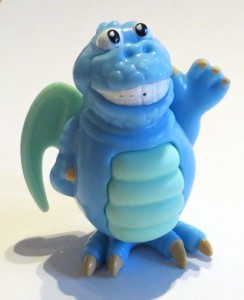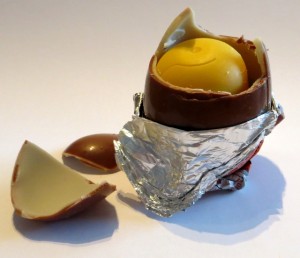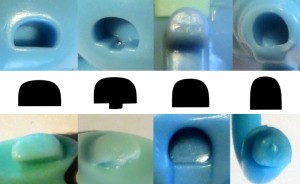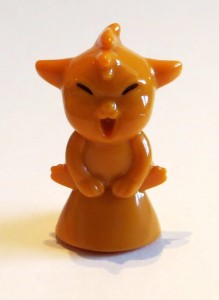
Mistake proofing (or Poka Yoke in Japanese) is one important way to avoid waste in lean manufacturing. In this post, I will present a small game that can be used to teach the basics of poka yoke easily and quickly. The game is based on Kinder Surprise eggs made by Ferrero, also known as a Kinder Egg. These eggs are available almost anywhere – except in the US, in which case there are some alternatives.
The Basics of Poka Yoke
Poka yoke, also known as mistake proofing, is a basic technique to avoid mistakes. Initially it was known as idiot proofing or baka yoke, but Shigeo Shingo changed the term to the more friendly mistake proofing, lest an employee would feel addressed as idiot.
The underlying idea is that a product should be designed in a way that makes it impossible to assemble it incorrectly. For example, at the back of your computer, most plugs fit into only the corresponding matching socket. This way you can’t mix up your speaker plugs with the monitor socket, reducing the likelihood of errors.
The technique can also be used in areas other than assembly and manufacturing. For example, in Germany, ATMs give you the cash only after you take back your bank card. This significantly reduces the risk of forgetting your card in the ATM (the money is rarely forgotten).
The Kinder Surprise Eggs

The poka yoke game is based on Kinder Surprise eggs. These eggs are widely available in Europe and Canada (For the US, see below). They contain a chocolate egg, which contains a small yellow capsule, which in turn contains a small toy.
These toys are the crucial part for our poka yoke game. Most of the toys require some assembly. These assembly steps can now be used to teach poka yoke.
The Toy Assembly
Assume, for example, you find a small toy for assembly in the egg as shown below. In this case, the toy is a blue dragon consisting of five components.

The egg also contains instructions and safety information (choking hazard unsuitable for children below age 3). Dispose of the instructions without reading. Rather, try to assemble the product without the instructions. In most cases, you will find this rather easy. Most toys are designed so that there are usually few or no possibilities to make mistakes. For example, the four attachments for the blue dragon body are designed so each attachment fits only the correct hole and also in the correct orientation.

The right wing will go only in the right hole. The left wing will fit only in the left hole. Similarly, the feet and the tail will fit only at the bottom and the back. All of them also can only be positioned in the right orientation (i.e., you cannot put the wings on backward even if you try). Hence, the design of the attachments is mistake proof or poka yoke.
However, some shapes are close enough to be initially confused, even though they do not fit. It would be a good discussion to think about different shapes that can be used to make the blue dragon even more mistake proof.
Assembly Options
Some toys can be assembled in more than one way. For example, the excavator below has four assembly options. In this case, it is interesting to find out which way you can mess up the assembly and which way you can’t. The excavator leaves you four options for assembly, three of which are incorrect.

Take for example the excavator above. Most of these mistakes are obvious. But each end fits in only one other part, and only the forward or backward orientation is ambiguous. An additional non-obvious mistake of putting the middle strut with the tool end into the machine is simply not possible. Only one end of the middle strut fits the engine, while the other end only fits the shovel. In this case, poka yoke does not allow this error. With exactly these thoughts, we pretty much arrived at the poka yoke game.
The Poka Yoke Game
The poka yoke game basically consists of handing out Kinder Surprise eggs to your trainees and having them dispose of the chocolate in a suitable way (I’m sure they will find a way they like). After opening the yellow containers in the eggs, tell them to ignore the paperwork and try to assemble the toys without the instructions. You then can discuss the following three questions:
- Can you assemble it correctly without instructions?
- Can you assemble it incorrectly?
- How would you design it to reduce errors even more?
Scale of the Game
The game is very well suited for classroom or workshop teaching. With smaller classes you can have an egg for every trainee or student. With larger classes you may use less eggs than students and have them work in groups. The game is surprisingly flexible, and the redundant chocolate will also improve the mood in the class.
Additionally, the game can be used for open house events and larger exhibitions. Anybody showing up gets an egg and has to assemble the product without instructions. This can be accompanied by a few posters explaining the theory. Trust me, it will be a popular booth in your open house. (Side note based on my experiences: If your booth is outside on a hot day, make sure your eggs are cooled. 😕 )
Non-Assembly Collectibles

Occasionally you will get a small toy that does not require assembly. In my experience, about one third of the eggs do not require assembly. For this case, I always keep a supply of toys for assembly at hand. The participant can keep the first toy and return the second toy after assembly.

Over the years I have collected quite a few eggs. For easier reference, I color code them according to their difficulty of assembly. Green dots are for easy eggs, red dots are for more difficult ones.
On a side note, I often find it more difficult to fit everything back in the egg afterward than I find it to assemble it in the first place 😉 .
Where to Get the Eggs?
In many countries in the world, these eggs are readily available in most supermarkets. Smaller quantities can be bought there easily. One egg costs around 1/2 Euro. For larger quantities (for example, if you need two thousand eggs for an open house), I recommend you contact your local Ferrero dealership directly and have a pallet shipped to you.
US Choking Hazard and Alternatives
As mentioned above, these eggs are available almost anywhere except the US. US laws prohibit any food with non-food items inside, to reduce the risk of choking. Hence these eggs are not available in the US. Some collectors do black market imports, but I strongly advise against smuggling Kinder Surprise eggs into the US. The penalties if caught are severe, and you leave yourself open for legal liability. Supposedly, about twenty-five thousand eggs are seized every year at the borders.
Recently, another company has found a loophole in the law and is selling similar Choco treasures, where the toy is not completely enclosed by chocolate. Unfortunately, these eggs usually have only completely assembled figurine inside, making them unsuitable for a poka yoke training.

One possibility I could think of is to stock up on eggs while in Canada or Europe. Dispose of the chocolate and take only the toys with you.
A second option is to look for similar toys without the chocolate. Possible keywords here are vending machine toys or buildable toys. Make sure there is some assembly required, or they are buildable. With a little bit of looking around, you should be able to find some suitable products for less than $1 per toy.
I hope this small game helps you in training others and also in your daily work. Now go out and improve your Industry!

When trying to understand the different elements of TPS, we should always remember Pavlov’s words. “Don’t just be a collector of facts. Try to penetrate to the secrets of their occurrence, persistently search for the laws that govern them.” Ivan Pavlov. – The comments below are an attempt to apply this thinking to Poke-Yoke. —
Understanding the basic principles for achieving waste free flow & zero defects is the foundation of lean operations. I had an opportunity in 1989 to discuss Poka-Yoke with Sensei Shingo himself. Below are extracts from my notes on his comments, and my own experiences over the last 29 years. — Initially he chided me for talking about it as an individual technique, & said it should be seen as the tool for implementing his system of ‘source inspection’ & guaranteeing zero defects.
He explained that traditional ‘long cycle’ inspection systems wait until an error in action produces a defective item, the defective item is then found by inspecting the output. His concept of source inspection uses the ‘short cycle’ inspection system. In this system the action itself is checked 100% using mechanical means. If an error occurs, immediate action is taken to correct it before a defect is produced. With this methodology we can guarantee zero defects to the final customer.—
The basic system is simple;
The PY methods/devices should be designed to detect deviation from the standard actions & outputs required to satisfy the customer’s requirements.
This can be done in three ways; a) Physical contact. b) Fixed values. c) Motion steps.
In some cases at the original design stage the part can be made a PY device by ensuring it can only be assembled/used in the correct way.—
They should also check for deviation in the 3M’s of actions & items;
Missing. Action or item not there.
Misplaced. Action or item there, but in wrong position.
Malformed. Action or item is there but wrong, size, shape, colour, temp etc.
When designing Poka-Yoke devices they must check for specific deviations in the 3M’s using; a, b & c. This can be done with a ‘what can be’ 3 M’s analysis.
The Poka-Yoke device should then;
1) Control the operation. Stop the process when an error or defect occurs.
2) Warn the operator. Signal to the operator that an error or defect has occurred.
They should be applied at the following check points;
1) The source action. (source check) This is the ideal as it gives zero defects.
2) Output of the action. (self check) . This is our second choice as the output will be defective if the PY device is activated, but it will not be passed to the internal customer.
3) Before the next process. (Successive check). At this stage the item will be defective if the PY device is activated, but it cannot go to the final customer.
With this system in place it is now possible to consistently achieve;
‘Zero Defects in our activities & production processes’. —
If applied to safety it is possible to achieve ‘Zero Accidents’. I do not understand why this methodology is not more widely used in this area. —
The most impressive example of Shingo’s system I have experienced was on an assembly line for inlet manifolds in Japan. We were allowed to work on the line & challenged to produce a defective assembly. It was impossible to produce one, & we had some very talented people trying. —
Once our front line people understand this system they become some of the best designers of Poka-Yoke devices. —
Poka-yoke should be seen as the device for implementing Shingo’s zero defects system.
The goal is to identify deviation from the desired conditions or actions in any situation.
A good example is the selector stick on an automatic car gearbox. If the stick is not in the park position the poke-yoke switch is not activated & the engine will not start. Zero defects in all situations. Shingo pointed out to me that this would be impossible to achieve with statistical techniques.